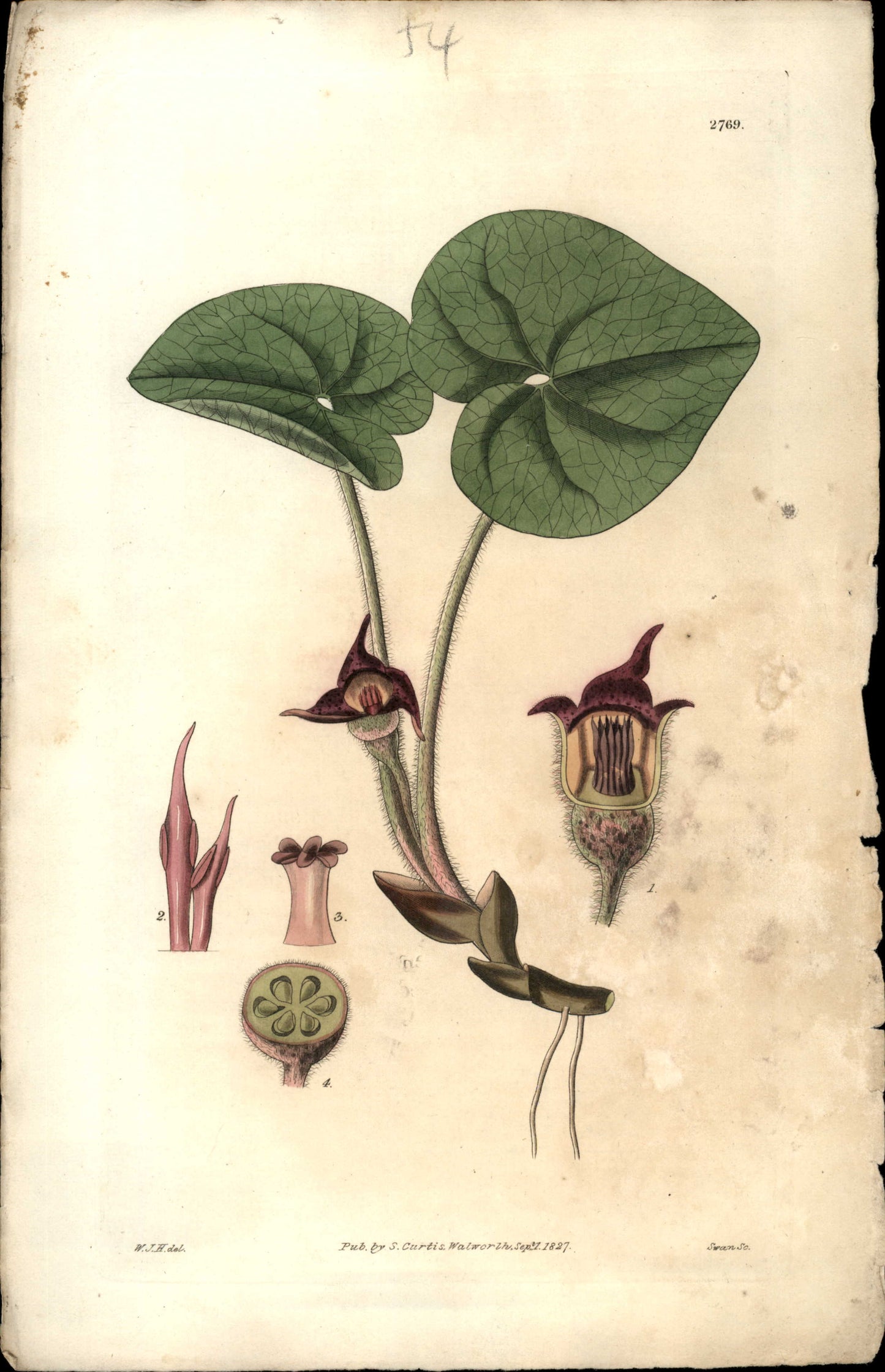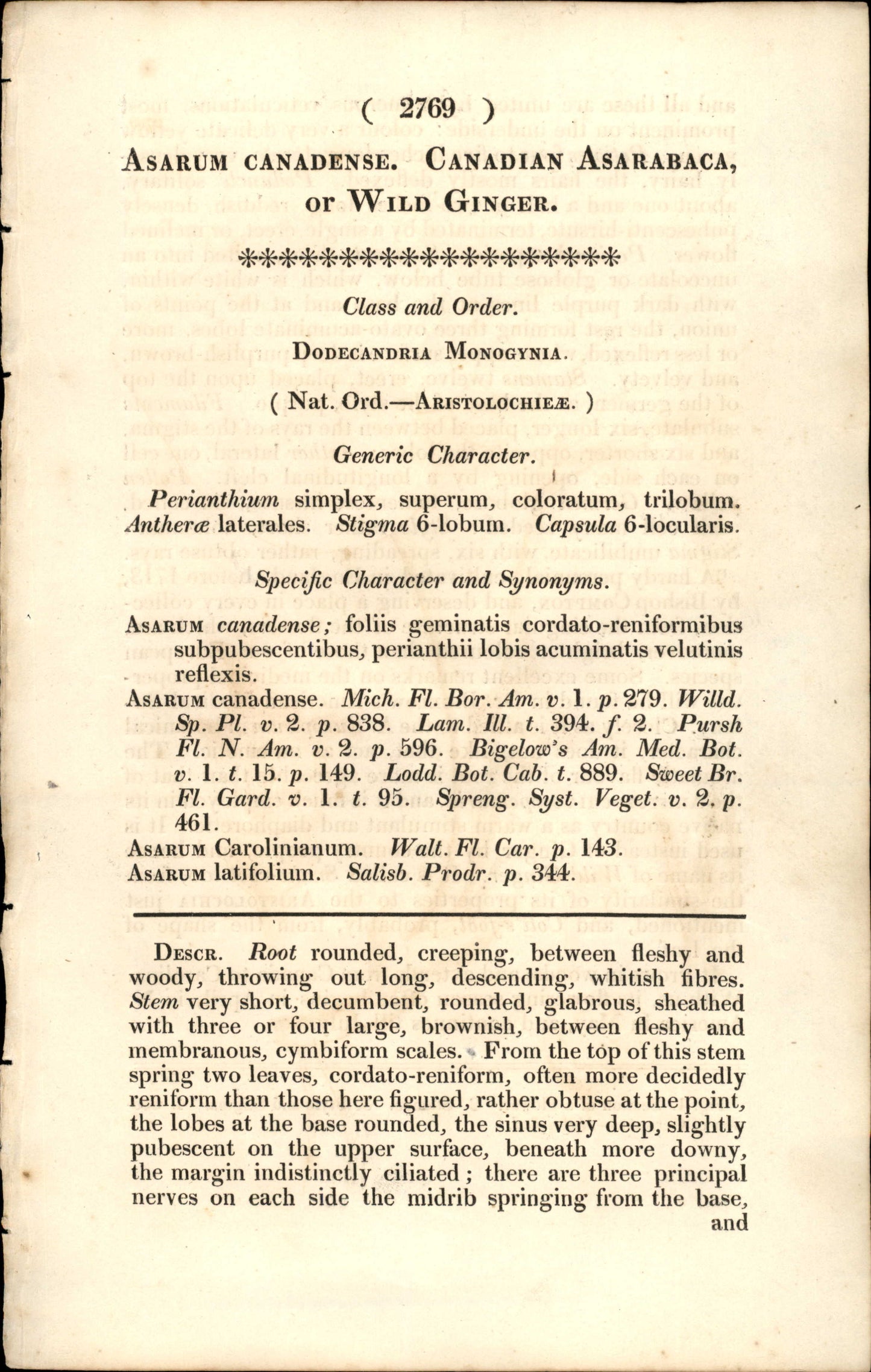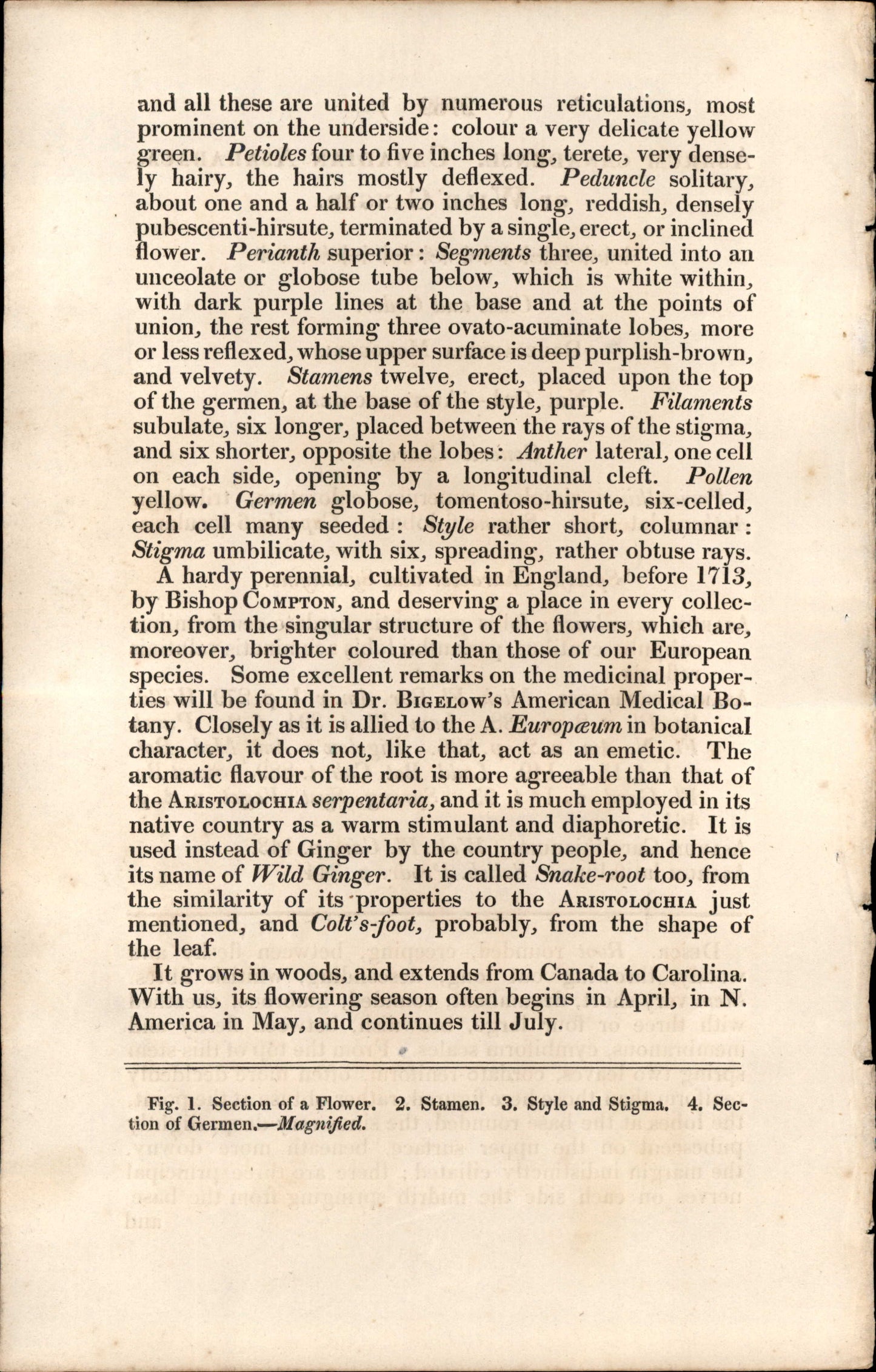Curtis Botanical Magazine
Plate 2769 - Canadian Asarabaca Or Wild Ginger
Plate 2769 - Canadian Asarabaca Or Wild Ginger
Couldn't load pickup availability
Plate 2769
Native Region: Europe
Flowering Period: May - July
Publication Date: Sep 1 1827
Description:
Complete Botanical Text (Cleaned)
W.J.H.del Pub by S Curtis Walworth Sep.1.1827 swan
Asarum Canadense Canadian Asarabaca or Wild Ginger
Class and Order
Dodecandria MONOGYNIA Oxollol 10 Nat Ord swird bepal
Generic Character
Perianthium simplex superum coloratum trilobum Anthera laterales stigma 6-lobum Capsula 6-locularis
Specific Character and Synonyms
Asarum canadense soliis geminatis cordato-reniformibus subpubescentibus perianthii lobis acuminatis velutinis you reflexis Asarum canadense Mich Fl Bor Am v 1 p 279 Willd sp Pl v 2 p 838 Lam Ill t 394 f 2 Pursh Fl N Am v 2 p 596 Bigelow's Am Med Bot v 1 t 15 p 149 Lodd Bot Cab t 889 sweet Br Fl Gard v 1 t 95 spreng syst Veget v 2 p 461.dib Asarum Carolinianum Walt Fl Car p 143 Asarum latisolium Salisb Prodr p 344
Description:
Root rounded creeping between fleshy and woody throwing out long descending whitish fibres stem very short decumbent rounded glabrous sheathed with three or sour large brownish between fleshy and membranous cymbiform scales From the top of this stem spring two leaves cordato-reniform often more decidedly reniform than those here figured rather obtuse at the point the lobes at the base rounded the sinus very deep slightly pubescent on the upper surface beneath more downy the margin indistinctly ciliated there are three principal nerves on each side the midrib springing from the base and and all these are united by numerous reticulations most prominent on the underside colour a very delicate yellow green Petioles sour to five inches long terete very dense ly hairy the hairs mostly deflexed Peduncle solitary about one and a half or two inches long reddish densely pubescenti-hirsute terminated by a single erect or inclined flower Perianth superior Segments three united into an unceolate or globose tube below which is white within with dark purple lines at the base and at the points of union the rest forming three ovato-acuminate lobes more or less reflexed whose upper surface is deep purplish-brown and velvety stamens twelve erect placed upon the top of the germen at the base of the style purple Filaments subulate six longer placed between the rays of the stigma and six shorter opposite the lobes Anther lateral one cell on each side opening by a longitudinal cleft Pollen yellow Germen globose tomentoso-hirsute six-celled each cell many seeded style rather short columnar stigma umbilicate with six spreading rather obtuse rays A hardy perennial cultivated in England besore 1713 by Bishop Compton and deserving a place in every collec tion from the singular structure of the flowers which are moreover brighter coloured than those of our European species Some excellent remarks on the medicinal proper ties will be sound in Dr Bigelow'S American Medical Bo tany Closely as it is allied to the A in botanical character it does not like that act as an emetic The aromatic flavour of the root is more agreeable than that of the Aristolochia Serpentaria and it is much employed in its native country as a warm stimulant and diaphoretic It is used instead of Ginger by the country people and hence its name of Wild Ginger It is called snake-root too from the similarity of its properties to the Aristolochia just mentioned and Colt's-foot probably from the shape of the leaf It grows in woods and extends from Canada to Carolina With us its flowering season often begins in April in N America in May and continues till July Fig 1 Section of a Flower 2 stamen 3 style and stigma 4 Sec tion of Germen.-Magnified
Raw OCR Text (Original)
3 2 4 54 1 2769 W.J.H.del Pub by S Curtis Walworth Sep.1.1827 swan So sour adapter(2769 so I firs Asarum Canadense Canadian Asarabaca or Wild Ginger Class and Order Dodecandria MONOGYNIA Oxollol 10 Nat Ord.- swird bepal Generic Character Perianthium simplex superum coloratum trilobum Anthera laterales stigma 6-lobum Capsula 6-locularis specific Character and synonyms Asarum canadense soliis geminatis cordato-reniformibus subpubescentibus perianthii lobis acuminatis velutinis you reflexis Asarum canadense Mich Fl Bor Am v 1 p 279 Willd sp Pl v 2 p 838 Lam Ill t 394 f 2 Pursh Fl N Am v 2 p 596 Bigelow's Am Med Bot v 1 t 15 p 149 Lodd Bot Cab t 889 sweet Br Fl Gard v 1 t 95 spreng syst Veget v 2 p 461.dib Asarum Carolinianum Walt Fl Car p 143 Asarum latisolium Salisb Prodr p 344 DEsCR Root rounded creeping between fleshy and woody throwing out long descending whitish fibres stem very short decumbent rounded glabrous sheathed with three or sour large brownish between fleshy and membranous cymbiform scales From the top of this stem spring two leaves cordato-reniform often more decidedly reniform than those here figured rather obtuse at the point the lobes at the base rounded the sinus very deep slightly pubescent on the upper surface beneath more downy the margin indistinctly ciliated there are three principal nerves on each side the midrib springing from the base and and all these are united by numerous reticulations most prominent on the underside colour a very delicate yellow green Petioles sour to five inches long terete very dense ly hairy the hairs mostly deflexed Peduncle solitary about one and a half or two inches long reddish densely pubescenti-hirsute terminated by a single erect or inclined flower Perianth superior Segments three united into an unceolate or globose tube below which is white within with dark purple lines at the base and at the points of union the rest forming three ovato-acuminate lobes more or less reflexed whose upper surface is deep purplish-brown and velvety stamens twelve erect placed upon the top of the germen at the base of the style purple Filaments subulate six longer placed between the rays of the stigma and six shorter opposite the lobes Anther lateral one cell on each side opening by a longitudinal cleft Pollen yellow Germen globose tomentoso-hirsute six-celled each cell many seeded style rather short columnar stigma umbilicate with six spreading rather obtuse rays A hardy perennial cultivated in England besore 1713 by Bishop Compton and deserving a place in every collec tion from the singular structure of the flowers which are moreover brighter coloured than those of our European species Some excellent remarks on the medicinal proper ties will be sound in Dr Bigelow'S American Medical Bo tany Closely as it is allied to the A in botanical character it does not like that act as an emetic The aromatic flavour of the root is more agreeable than that of the Aristolochia Serpentaria and it is much employed in its native country as a warm stimulant and diaphoretic It is used instead of Ginger by the country people and hence its name of Wild Ginger It is called snake-root too from the similarity of its properties to the Aristolochia just mentioned and Colt's-foot probably from the shape of the leaf It grows in woods and extends from Canada to Carolina With us its flowering season often begins in April in N America in May and continues till July Fig 1 Section of a Flower 2 stamen 3 style and stigma 4 Sec tion of Germen.-Magnified
Original botanical print from Curtis's Botanical Magazine
Share







